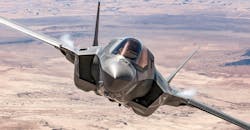F-35 Certified for Full Rate Production
The U.S. Dept. of Defense confirmed that the F-35 Joint Strike Fighter program has achieved “full-rate production,” signifying the Pentagon has completed and approved the results of operational testing on the single-engine, Stealth-enabled aircraft. The Milestone C / Full Rate Production (MSC/FRP) classification means the F-35 program is “well positioned to efficiently produce and deliver the next generation of aircraft to meet the evolving needs of our services, partners, and Foreign Military Sales customers,” according to the Pentagon announcement.
As noted, the MSC/FRP designation recognizes that the F-35 program leaders demonstrated “control of the manufacturing process, acceptable performance and reliability, and the establishment of adequate sustainment and support systems.” This is significant because cost-overruns, the availability of spare parts and systems, and software updates have been frequently cited by the Pentagon in its disputes with the F-35 program leader, Lockheed Martin
“This is a major achievement for the F-35 program,” stated Under Secretary of Defense for Acquisition and Sustainment William A. LaPlante, who chairs the Defense Acquisition Board, DoD’s top authority for reviewing and authorizing critical decisions concerning acquisition programs.
The new designation also could give the Pentagon and the program’s major manufacturing entities, chiefly Lockheed and Pratt & Whitney, an argument for increased funding of the F-35 program. Budget cuts have been predicted based on the two-year budget deal agreed by the U.S. Congress and White House in 2023.
The F-35 is a series of fighter jets deployed for ground attack and combat, and available in three variants, for the U.S. Air Force, U.S. Marine Corps, and U.S. Navy, as well as the defense forces of 17 other nations. It is by far the largest and most expensive U.S. defense program, with Lockheed subject to steady scrutiny for cost overruns and the readiness of aircraft for service.
More than 1,000 F-35s have been produced since the launch of the program in 2006. Currently, Lockheed is scheduled to produce 83 of the fighter jets in 2025.
The design of the aircraft is scheduled to be extensively updated in order to accommodate new hardware and software packages to improve data processing power and speed systems. The technology supporting TR-3 is still being tested and will not be available until at least late this year.
